
Cyamopsis is a genus of the family Fabaceae. Its species are distributed across sub-Saharan Africa, Saudi Arabia, Pakistan, and India. Typical habitats include tropical seasonally-dry thorn scrub and grassland, often in floodplains, stream beds, and pans, and in open sandy or rocky areas.

Wiborgia is a genus of plants in the family Fabaceae. It is found in Africa and was named for Erik Viborg by Carl Peter Thunberg.

Baptisia is a genus in the legume family, Fabaceae. They are flowering herbaceous perennial plants with pea-like flowers, followed by pods, which are sometimes inflated. They are native to woodland and grassland in eastern and southern North America. The species most commonly found in cultivation is B. australis.

Pericopsis is a genus of flowering plants in the legume family, Fabaceae. It includes four species of trees and shrubs, three native to sub-Saharan Africa and one to Sri Lanka, Malesia, New Guinea, and the Caroline Islands. Typical habitats include tropical lowland forest and seasonally-dry woodland and wooded grassland.

Adenolobus is a genus of African flowering plants in the legume family, Fabaceae. It belongs to the subfamily Cercidoideae.

Griffonia is a genus of central African flowering plants in the legume family, Fabaceae. It belongs to the subfamily Cercidoideae. Griffonia is known to have a high concentration of 5-HTP in its seeds.
Bobgunnia is a genus of flowering plants in the legume family, Fabaceae. It belongs to the subfamily Faboideae. It includes two species native to sub-Saharan Africa. The genus is named for Charles R. Gunn who was the director of the U.S. National Seed Herbarium for many years before his retirement.

Bolusanthus speciosus is a species of flowering plants in the family Fabaceae. It belongs to the subfamily Faboideae. It is the only member of the genus Bolusanthus.
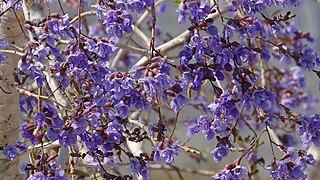
Bowdichia is a genus of flowering plants in the legume family, Fabaceae. It belongs to the subfamily Faboideae. The genus includes two species native to tropical South America and Costa Rica.
Harleyodendron unifoliolatum is a species of flowering plant in the legume family, Fabaceae. It belongs to the subfamily Faboideae. It is the only member of the genus Harleyodendron. It is a tree endemic to northeastern Brazil.

Hesperolaburnum platycarpum is a species of flowering plants in the family Fabaceae. It belongs to the subfamily Faboideae. It is the only member of the genus Hesperolaburnum. It is a tree or shrub endemic to Morocco.

Humularia is a genus of flowering plants in the legume family, Fabaceae. It includes 34 species native to sub-Saharan Africa, ranging from South Sudan to Cameroon, Angola, Malawi, and Tanzania. Species include herbs with woody bases and occasionally small shrubs. Typical habitats include seasonally-dry tropical woodland, wooded grassland, scrub, and grassland, often along stream banks, swamp margins, floodplains, and sandy areas, and sometimes in montane areas. The genus belongs to the subfamily Faboideae, and was recently assigned to the informal monophyletic Dalbergia clade of the Dalbergieae.
Mildbraediodendron excelsum is a species of flowering plant in the family Fabaceae, and the only species in the genus Mildbraediodendron. It is a tree native to sub-Saharan Africa, ranging from Ghana to South Sudan, Uganda, and Democratic Republic of the Congo. It grows in Guineo-Congolian forest and Victoria Basin forest–savanna mosaic. It belongs to the subfamily Faboideae.
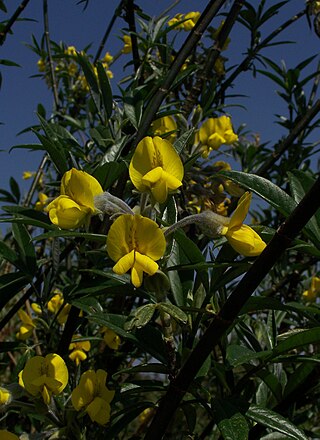
Piptanthus is a genus of flowering plants in the legume family, Fabaceae. It includes two species of shrubs native to the Himalayas, Tibet, Myanmar, and western China. They grow in montane grassland, thicket, and forest margins.

Plagiocarpus is a genus of flowering plants in the legume family, Fabaceae. It includes seven species of shrubs or subshrubs native to northern Australia, from the Kimberley region of Western Australia to western Queensland. Their habitats include seasonally-dry tropical to subtropical woodland, bushland and thicket, shrubland, and grassland, typically on sandstone or sandy soils. It belongs to the subfamily Faboideae.
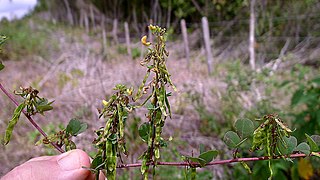
Poiretia is a genus of flowering plants in the legume family, Fabaceae. It includes 12 species of twining, scandent, or erect herbs and shrubs native to the tropical Americas, ranging from southern Mexico to northern Argentina, including Cuba and Hispaniola. Most species are native to eastern Brazil, Paraguay, and northern Argentina; Poiretia punctata ranges further north and west to northern South America, Central America, Mexico, and the Caribbean. Typical habitats include seasonally-dry tropical to subtropical riverine forest, woodland (cerrado), grassland, and shrubland.
Polhillia is a genus of flowering plants in the family Fabaceae. It includes 11 species of shrubs and herbs native to the Cape Provinces of South Africa. They grow in Mediterranean-climate renosterveld (shrubland) and scrub-grassland, typically in heavy soils. The genus belongs to subfamily Faboideae.
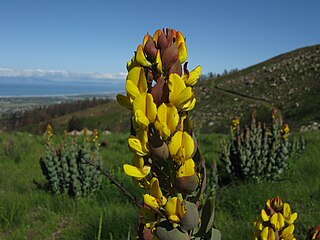
Rafnia is a genus of flowering plants in the family Fabaceae. It includes 29 species of shrubs and subshrubs native to South Africa. They grow in Mediterranean-climate fynbos (shrubland) and grassland, mostly on rocky and sandy soils. Most are native to the Cape Provinces, with some extending eastwards into KwaZulu-Natal. It belongs to subfamily Faboideae.
Rhynchotropis is a genus of flowering plants in the legume family, Fabaceae. It includes two species of herbs native to the Democratic Republic of the Congo, Angola, and Zambia. Typical habitats include seasonally-dry tropical woodland and wooded grassland in the northern Zambezian region, often in seasonally-damp or open sandy and rocky areas. It belongs to tribe Indigofereae of subfamily Faboideae.
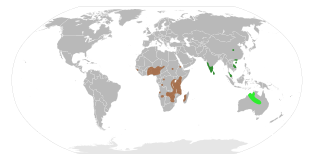
Rothia is a genus of flowering plants in the family Fabaceae. It belongs to the tribe Crotalarieae of subfamily Faboideae, and comprises two species:














